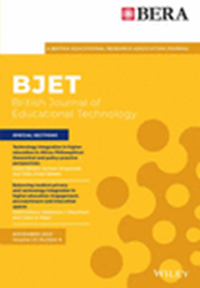A dual-process motivation mediation model to explain female high school students' cognitive engagement and disengagement in emergency remote teaching and online learning in South Korea
Abstract
High attrition/dropout rates and low engagement have been major concerns of online educators. This study examined female high school students' cognitive engagement and disengagement in an online learning context during the COVID-19 pandemic through the lens of self-determination theory's basic psychological needs. We investigated an extended dual-process motivation mediation model that emphasizes the mediating role of the need for competence, including an additional factor, technology self-efficacy, in a South Korean high school context (n = 235). Results from structural equation modelling provided evidence for the proposed model. Our findings indicated that the exogenous variables (ie, perceived autonomy support, perceived teacher control and technology self-efficacy) predicted cognitive engagement and disengagement with the mediating role of competence need satisfaction and competence need frustration. We found distinct processes including (a) “autonomy support-competence need satisfaction-cognitive engagement”, (b) “teacher control-competence need frustration-cognitive disengagement”, (c) “technology self-efficacy-competence need satisfaction-cognitive engagement” and (d) “technology self-efficacy-competence need frustration (negative effect)-cognitive disengagement”. This study suggests using autonomy support strategies to fulfil students' competence needs in online learning contexts. We also found a possible role of technology self-efficacy in influencing psychological competence needs, cognitive engagement and cognitive disengagement in online learning contexts. Implications of the findings are discussed.
Practitioner notes
What is already known about this topic
- High attrition/dropout rates and low engagement have been major concerns of online educators.
- Emergency remote teaching (ERT) has implications for online teaching beyond the ERT paradigm.
- Self-determination theory (SDT) has been adopted and adapted with the goal of determining how to achieve need satisfaction, optimize learner motivation and enhance student engagement in classroom settings.
What this paper adds
- This study applied a dual-process motivation mediation model to investigate both cognitive engagement and disengagement among female high school students in an ERT online learning environment.
- The extended dual-process motivation mediation model examined the role of an additional factor, technology self-efficacy in cognitive engagement and disengagement in online learning.
- This study examined the role of direct, indirect and cross-over effects focusing on both bright and dark aspects of the dual-process motivation mediation model in online learning in a South Korean girls' high school during ERT.
Implications for practice and/or policy
- This study proposes the use of autonomy support strategies in online learning contexts.
- Teachers should understand their students and provide support that addresses competence need satisfaction to enhance student cognitive engagement in online learning contexts.
- More efforts should be made to prepare teachers for designing online learning experiences that increase students' competence need satisfaction and decrease competence need frustration.



 求助内容:
求助内容: 应助结果提醒方式:
应助结果提醒方式:


